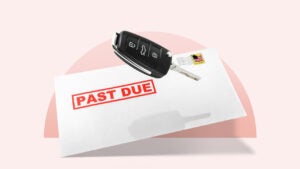TransUnion report highlights affordability challenges in the auto market

Key takeaways
- A growing number of consumers are financing more than the cost of their vehicle, putting them upside-down in their auto loan from the very beginning of repayment.
- Account delinquencies have exceeded their 2009 peak during the Great Recession.
- Average vehicle monthly payments have risen faster than the inflation rate.
- Despite a challenging market, there are strategies you can employ to ensure you don’t get in over your head with an unaffordable auto loan.
TransUnion’s Auto Credit Industry Insights report from the fourth quarter of 2024 highlighted affordability as a significant barrier for consumers. High car prices, high annual percentage rates (APRs) and inflation pose big challenges to shoppers searching for their next vehicle.
While consumers with low incomes and poor credit scores are the hardest hit, higher-income consumers are feeling the effects as well, with many holding onto their vehicles longer to avoid taking on a large auto loan at a high rate.
Loan-to-value ratios on new auto loans have increased
Average LTV for used auto loans: 127%
The average loan-to-value (LTV) ratio of all used car purchases rose to 127 percent — its highest point in five years — with more than half of all used cars being financed for more than they are worth. The number of used car LTVs above 120 percent has more than doubled in the past three years, from 27 percent to 54 percent.
The LTV of an auto loan compares the financed amount to the car’s value. For example, if you buy a car worth $50,000 but choose to finance the add-ons (like an extended warranty and gap coverage) for a total loan balance of $60,000, your LTV is 120 percent. (60,000 / 50,000 = 1.2, or 120 percent)
A lower LTV indicates a bigger down payment and lower amount financed, while a higher LTV could indicate:
- A small down payment, or no down payment
- Borrowing to cover add-ons or expenses like sales tax, title and license fees
- Using cash-out auto refinancing to pay off a prior auto loan
While borrowing more than the value of a car can be helpful, it puts the borrower at risk of an upside-down auto loan right from the start. Since upside-down loans are riskier for lenders, you may also receive a higher APR, further increasing your borrowing costs.
Strategies to avoid a high LTV
- Make a down payment. Traditionally, lenders have expected 20 percent down, but with vehicle prices skyrocketing, many finance companies have become more lenient. If you can’t make a 20 percent down payment, put down what you can afford without depleting your emergency reserves.
- Don’t finance taxes and fees. Anything you finance adds to the amount you have to borrow. If possible, cover these costs with cash. While some fees are mandated by law, others may be negotiable.
- Avoid unnecessary add-ons. Dealerships are happy to add bells and whistles to your purchase, but each upgrade increases your debt load. Look for base models (not extended or luxury editions) that offer the features you truly need.
- Choose your vehicle carefully. Vehicles with slower depreciation and good resale value will help you avoid becoming upside-down in your current loan and needing a cash-out refinance down the road.
Account delinquencies rose by five basis points
1.47% of auto loans are more than 60 days delinquent
The number of auto loans that are more than 60 days delinquent grew by five basis points in the fourth quarter of 2024 to 1.47 percent. That number exceeds the 2009 peak of 1.45 percent set during the Great Recession.
An account becomes delinquent when you fail to make the minimum payment by the due date. After a payment is more than 30 days late, it is usually reported to the credit bureaus, remaining on your credit history for up to seven years. In addition to the long-lasting negative effects on your credit, you may also have to pay late fees.
Delinquency rates were much higher among subprime borrowers than among those with fair or good credit. Low credit scores can indicate past problems repaying debt or a high debt-to-income (DTI) ratio, factors that put borrowers at higher risk of delinquency, defaulting on their auto loan and possibly losing their vehicle.
Strategies to avoid auto loan delinquency
- Know your financial situation before you borrow. Keep a monthly budget with a list of all income and expenses to understand what you can comfortably afford.
- Add up the true cost of car ownership. In addition to your monthly payment, you’ll need to cover the costs of insurance, maintenance, parking and fuel.
- Maintain a low DTI. Calculate your debt-to-income ratio to tell whether you’re carrying too much debt to take on an auto loan. A DTI of 36 percent or lower is considered good, and you may not qualify if your DTI is over 50 percent.
- Calculate your monthly payments. Use an auto loan calculator to estimate your payment with different repayment terms. You can also use prequalification to determine what terms lenders will offer you without impacting your credit score.
- Set up autopay. If you’re enrolled in automatic payments, you won’t forget to pay your bill on time, and you may even qualify for a slight discount.
If you already have an auto loan and are falling behind, you have options before defaulting. You can request a car loan modification that reduces your monthly payments, lowers your interest rate or moves your payment due date. You may also qualify for an auto loan hardship program if you’re struggling with a financial emergency.
Average monthly auto loan payments increased faster than general inflation
Monthly auto loan payments for new cars increased 30% since 2019
Although wages have increased in recent years, those gains were negated by auto loan payments that have grown faster than general inflation. In fact, the average new and used vehicle payments increased by 30 percent, while inflation was up 22.8 percent. So, even in this era of high inflation and costs, auto loans are disproportionately expensive.
Generally, your monthly car payment shouldn’t exceed 10 to 15 percent of your monthly take-home pay. But for lower-income consumers, the average new vehicle monthly payment is now over 20 percent. Monthly payments for used vehicles are also high, at just under 20 percent for low-income consumers and above 2019 levels for all borrowers.
If you borrow an auto loan that’s too expensive for your budget, you’re more likely to fall behind on the payments and default on the loan. With vehicle prices near an all-time high, the average consumer has an increasingly difficult time affording that new (or new-to-you) vehicle.
Strategies to avoid an unaffordable auto loan
- Improve your credit score. Auto loan rates have decreased for borrowers with good and excellent credit, according to Q4 2024 data from Experian. A good credit score can also help you negotiate lower monthly payments. If you can afford to delay your purchase, focus on repairing your credit score before shopping for a new car.
- Make a bigger down payment. This might mean saving for longer before making your purchase, or you could choose a less expensive vehicle to stretch your down payment further.
- Shop with multiple lenders. The auto loan terms you’re offered depend on your financial situation and credit history, but they also depend on the lender’s size, risk tolerance and the type of loans it specializes in. Comparison shopping can give you a sense of the available terms and may help you choose the best auto loan rates for your car-buying goals.
- Choose a longer term. Generally, you should choose the shortest term you can afford to minimize the amount of interest you pay. However, if you need a car and high monthly payments are a barrier, a longer term could drop your monthly payments enough to avoid breaking your budget. A high credit score could help you qualify for a low interest rate that would balance out paying interest for longer, or consider a cosigner if your credit score isn’t high enough to qualify for the best rates.
- Consider bad credit auto loans carefully. These loans come with higher interest rates, and some are loaded with extra fees. However, the best bad credit auto loans can get you in a vehicle and help you start repairing your credit. Thoroughly review the lender’s terms and read customer reviews to sort the reliable lenders from those you should avoid.
Bottom line
Today’s auto market is a challenging one, with rapid price increases, high APRs and a shortage of affordable used vehicles. But practicing healthy financial habits, budgeting and comparison shopping can still help you make smart choices when shopping for auto loans.
Why we ask for feedback Your feedback helps us improve our content and services. It takes less than a minute to complete.
Your responses are anonymous and will only be used for improving our website.






